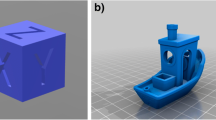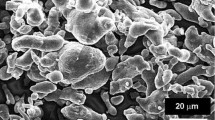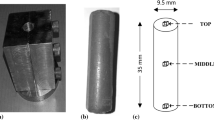Abstract
The 3D printing of metals and ceramics by the extrusion of a powder/thermoplastic binder feedstock is an extrusion-based additive manufacturing (EAM) technique and has received significant interest. EAM feedstocks are generally characterized by their shear viscosity. A quantitative comparison with the shear flow data, through an estimation of the Trouton ratio, indicates that the extensional viscosities are three orders of magnitude greater than their shear flow viscosity at a comparable shear rate obtained in three different high loaded polymers retained for this study. This experimental study addresses the unsolved issue of the role of elongational viscosity in the modelling of EAM of highly viscous melts. The study was conducted using three feedstocks with a water-soluble binder and high powder loading. The different powder materials used for this study are stainless steel, alumina and zirconia. Initially, the rheological properties of the feedstocks were assessed using capillary rheometers. A pressure drop model based on the shear and elongational components of the viscosity was proposed to predict the extrusion pressure during capillary tests. The model was adapted to develop a specific EAM machine, namely, an EFeSTO, equipped with a pellet extrusion unit. Experimental EAM tests were conducted, and the pressure drops were analytically predicted and experimentally measured. A total of 31 different combinations of extrusion velocities, nozzle diameters, 3D printed shapes and materials were tested through a total 184 experimental runs. The model predicts well the experimental pressures for the steel feedstock, whereas it underestimates the pressure for the two ceramic feedstocks owing to their different thermal properties. The results of this study clearly demonstrate that the pressure, and therefore the material flow during the EAM processes of viscous materials, cannot be modelled well without considering the elongational viscosity.











Similar content being viewed by others
References
Royer A, Barrière T, Gelin JC (2016) Development and characterization of a metal injection molding bio sourced inconel 718 feedstock based on polyhydroxyalkanoates. Metals (Basel) 6. https://doi.org/10.3390/met6040089
Rane K, Strano M (2019) A comprehensive review of extrusion-based additive manufacturing processes for rapid production of metallic and ceramic parts. Adv Manuf 7:155–173. https://doi.org/10.1007/s40436-019-00253-6
Chen Z, Li Z, Li J, Liu C, Lao C, Fu Y, Liu C, Li Y, Wang P, He Y (2019) 3D printing of ceramics: a review. J Eur Ceram Soc 39:661–687. https://doi.org/10.1016/j.jeurceramsoc.2018.11.013
Nadernezhad A, Unal S, Khani NKB (2019) Material extrusion-based additive manufacturing of structurally controlled poly(lactic acid)/carbon nanotube nanocomposites. Int J Adv Manuf Technol 102:2119–2132
Annoni M, Giberti H, Strano M (2016) Feasibility study of an extrusion-based direct metal additive manufacturing technique. Procedia Manuf 5:916–927. https://doi.org/10.1016/j.promfg.2016.08.079
Strano M, Rane K, Briatico Vangosa F, Di Landro L (2019) Extrusion of metal powder-polymer mixtures: melt rheology and process stability. J Mater Process Technol 273:116250. https://doi.org/10.1016/j.jmatprotec.2019.116250
Hidalgo J, Jiménez-Morales A, Barriere T, Gelin JC, Torralba JM (2015) Capillary rheology studies of INVAR 36 feedstocks for powder injection moulding. Powder Technol 273:1–7. https://doi.org/10.1016/j.powtec.2014.12.027
Dimitri C, Mohamed S, Thierry B, Jean-Claude G (2017) Influence of particle-size distribution and temperature on the rheological properties of highly concentrated Inconel feedstock alloy 718. Powder Technol 322:273–289. https://doi.org/10.1016/j.powtec.2017.08.049
Rane K, Di Landro L, Strano M (2019) Processability of SS316L powder - binder mixtures for vertical extrusion and deposition on table tests. Powder Technol 345:553–562. https://doi.org/10.1016/j.powtec.2019.01.010
Turner BN, Strong RA, Gold S (2014) A review of melt extrusion additive manufacturing processes: I. Process design and modeling. Rapid Prototyp J 20:192–204. https://doi.org/10.1108/RPJ-01-2013-0012
Mackay ME (2018) The importance of rheological behavior in the additive manufacturing technique material extrusion. J Rheol (N Y N Y) 62:1549–1561. https://doi.org/10.1122/1.5037687
Singh P, Shaikh Q, Balla VK, Atre SV, Kate KH (2019) Estimating powder-polymer material properties used in design for metal fused filament fabrication (DfMF 3). JOM. https://doi.org/10.1007/s11837-019-03920-y
Faes M, Vleugels J, Vogeler F, Ferraris E (2016) Extrusion-based additive manufacturing of ZrO2 using photoinitiated polymerization. CIRP J Manuf Sci Technol 14:28–34. https://doi.org/10.1016/j.cirpj.2016.05.002
Kukla C, Gonzalez-Gutierrez J, Duretek I, Schuschnigg S, Holzer C (2017) Effect of particle size on the properties of highly-filled polymers for fused filament fabrication. AIP Conf Proc 1914. https://doi.org/10.1063/1.5016795
Khaliq MH, Gomes R, Fernandes C, Nóbrega J, Carneiro OS, Ferrás LL (2017) On the use of high viscosity polymers in the fused filament fabrication process. Rapid Prototyp J 23:727–735. https://doi.org/10.1108/RPJ-02-2016-0027
Coogan TJ, Kazmer DO (2019) In-line rheological monitoring of fused deposition modeling. J Rheol (N Y N Y) 63:141–155. https://doi.org/10.1122/1.5054648
Thavanayagam G, Pickering KL, Swan JE, Cao P (2015) Analysis of rheological behaviour of titanium feedstocks formulated with a water-soluble binder system for powder injection moulding. Powder Technol 269:227–232. https://doi.org/10.1016/j.powtec.2014.09.020
Khakbiz M, Simchi A, Bagheri R (2005) Analysis of the rheological behavior and stability of 316L stainless steel–TiC powder injection molding feedstock. Mater Sci Eng A 407:105–113. https://doi.org/10.1016/j.msea.2005.06.057
Park SJ, Kim D, Lin D, Park SJ, Ahn S (2017) Rheological characterization of powder mixture including a space holder and its application to metal injection molding. Metals (Basel) 7. https://doi.org/10.3390/met7040120
Huang B, Liang S, Qu X (2003) The rheology of metal injection molding. J Mater Process Technol 137:132–137. https://doi.org/10.1016/S0924-0136(02)01100-7
Samanta SK, Chattopadhyay H, Godkhindi MM (2011) Thermo-physical characterization of binder and feedstock for single and multiphase flow of PIM 316L feedstock. J Mater Process Technol 211:2114–2122. https://doi.org/10.1016/j.jmatprotec.2011.07.008
Huang JC, Leong KS (2002) Shear viscosity, extensional viscosity, and die swell of polypropylene in capillary flow with pressure dependency. J Appl Polym Sci 84:1269–1276. https://doi.org/10.1002/app.10466
Aho J, Syrjälä S (2011) Shear viscosity measurements of polymer melts using injection molding machine with adjustable slit die. Polym Test 30:595–601. https://doi.org/10.1016/j.polymertesting.2011.04.014
Ohtani H, Ellwood K, Pereira G, Chinen T, Selvasekar S (2017) Extensional rheology: new dimension of characterizing automotive fluids. SAE Tech Pap. https://doi.org/10.4271/2017-01-0364
Cogswell FN (1972) Measuring the extensional rheology of polymer melts. Trans Soc Rheol 16:383–403. https://doi.org/10.1122/1.549257
Zatloukal M, Musil J (2009) Analysis of entrance pressure drop techniques for extensional viscosity determination. Polym Test 28:843–853. https://doi.org/10.1016/j.polymertesting.2009.07.007
Hong SY, Broomer M (2000) Economical and ecological cryogenic machining of AISI 304 austenitic stainless steel. Clean Prod Process 2:0157–0166. https://doi.org/10.1007/s100980000073
Arabo EYM (2011) Shear and extensional viscosities of hard wheat flour dough using a capillary rheometer. J Food Eng 103:294–298. https://doi.org/10.1016/j.jfoodeng.2010.10.027
Parenti P, Cataldo S, Grigis A, Covelli M, Annoni M (2019) Implementation of hybrid additive manufacturing based on extrusion of feedstock and milling. Procedia Manuf 34:738–746. https://doi.org/10.1016/j.promfg.2019.06.230
Heaney DF (2012) Handbook of Metal Injection Molding, 1st edn. Woodhead Publishing
Liu ZY, Loh NH, Tor SB, Khor KA (2003) Characterization of powder injection molding feedstock. Mater Charact 49:313–320. https://doi.org/10.1016/S1044-5803(02)00282-6
Vergnes B (2015) Extrusion defects and flow instabilities of molten polymers. Int Polym Process 30:3–28. https://doi.org/10.3139/217.3011
Kishore V, Ajinjeru C, Liu P, Lindahl J, Hassen A, Kunc V et al (2017) Predicting sharkskin instability in extrusion additive manufacturing of reinforced thermoplastics. Solid Free Fabr Symp:1696–1704
Rane K, Petrò S, Strano M (2020) Evolution of porosity and geometrical quality through the ceramic extrusion additive manufacturing process stages. Addit Manuf 32:101038. https://doi.org/10.1016/j.addma.2020.101038
Strano M, Rane K, Herve G, Tosi A (2019) Determination of process induced dimensional variations of ceramic parts, 3d printed by extrusion of a powder-binder feedstock. Procedia Manuf 34:560–565. https://doi.org/10.1016/j.promfg.2019.06.220
Zhou X, Hsieh SJ, Wang JC (2019) Accelerating extrusion-based additive manufacturing optimization processes with surrogate-based multi-fidelity models. Int J Adv Manuf Technol 103:4071–4083
Fotovvati BAE (2019) Size effects on geometrical accuracy for additive manufacturingof Ti-6Al-4V ELI parts. Int J Adv Manuf Technol 104:2951–2959
Author information
Authors and Affiliations
Corresponding author
Additional information
Publisher’s note
Springer Nature remains neutral with regard to jurisdictional claims in published maps and institutional affiliations.
Rights and permissions
About this article
Cite this article
Rane, K., Barriere, T. & Strano, M. Role of elongational viscosity of feedstock in extrusion-based additive manufacturing of powder-binder mixtures . Int J Adv Manuf Technol 107, 4389–4402 (2020). https://doi.org/10.1007/s00170-020-05323-9
Received:
Accepted:
Published:
Issue Date:
DOI: https://doi.org/10.1007/s00170-020-05323-9




